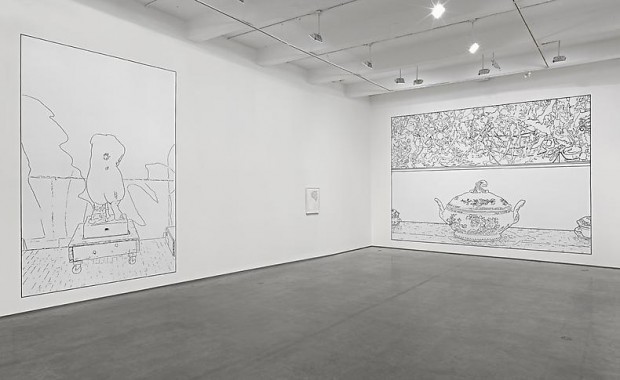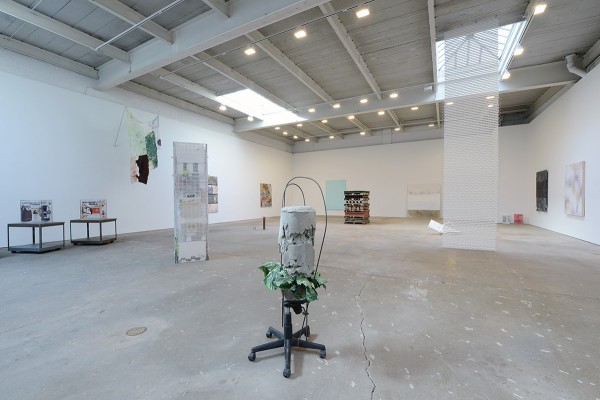Louise Lawler: No Drones
Metro Pictures
519 West 24th Street
New York, NY 10011
Runs through July 25, 2014
What’s on view: Large black-and-white tracings of Lawler’s photographs of artworks, often taking place in a museum setting. Also for sale: $500 posters for the show and glasses that have been inscribed with “no drones.”
Corinna: Where the drones at? Any ideas, guys?
Andrew: I went in thinking I’d be getting a whole new and politicized side of Louise Lawler and instead got…tracings of her old photographs, only bigger. I actually enjoyed looking at these more than I do her photographs. In her photographs of artworks, there’s a level of remove and distance, but in the tracings you (literally) get to see more of her own hand. It feels like she’s loosening up a bit: These works are less severe, more fun. What any of this has to do with drones is beyond me.
Corinna: Overall, the exhibition seemed like a trivia game for art-world insiders: Can you recognize these super-important works of art when they’re only shown in black and white? If you’re good at the game, you’d end up pointing out the works by Fontana, Judd, Warhol, and Hirst.
Other than that, I didn’t get much else out of the show, or a deeper understanding of why Lawler would end up making tracings of her own photographs of other people’s artworks. She’s making a potentially endless stream of appropriations, but I don’t see what her endgame is.
Anyway, it was a fun enough game to play for a minute or two.
Henry: If I were to guess why this show is called No Drones—and this may be a stretch—is that a drone is an unmanned ship, a soulless actor, sort of in the same way her pared-down portraits of famous artworks are soulless. The portraits of famous works take away the texture, color, feeling, and commentary of Pollock, Hirst, and Warhol, and just become an icon of the work, a.k.a. a soulless being, a.k.a. a drone. Perhaps.
Corinna: Well, I do remember reading Mignon Nixon’s review of Lawler’s No Drones show in London a while back, and she seemed to find some politics there. Some of the works in that show—like Lawler’s riff on Gerhard Richter’s “Mustang Squadron” (1964)—had a slightly more of a political air than the works in the Metro Pictures version.
To do as one would
David Zwirner
519 West 19th Street
New York, NY 10011
Runs through July 25, 2014
What’s on view: A group show of fifteen artists revolving around utilitarianism and industrial materials. Sculptures made out of cement, paintings of chain-link fences, and transparent appliance packaging. Artists include everyone from established names like Christopher Williams to younger ones like Ann Green Kelly. The show was curated by David Zwirner sales assistant Mary Mitsch and gallery assistants Martha Moldovan and Poppy Pulitzer.
Andrew: Between the hanging fence, the fake grass, and sculpture after sculpture of cement, this looked like an arty Home Depot.
Henry: True. The press release name drops (albeit fittingly) the 19th century philosopher John Stuart Mill’s text Utilitarianism, which off the bat makes me think the curators are trying to have some deep discussion about the aesthetics of use. Honestly, though, I thought the thread tying all of the works together was mostly the artist’s shared interest in a witty use of materials—and less about any heavy philosophical statements.
There’s the classic Herman Miller chair base with a plant and a poured cement block perched on top of it by Violet Dennison, which, because of its human scale and the chair legs, looks like the rubble from a demolished office building coalesced into an alien lifeform. The Christopher Williams pieces in the show have a similar anthropomorphic feeling, but they’re less intentionally ugly and aren’t as silly.
There’s a totem-like building in the center of the room by artist Xavier Donnelly made with D-grade construction techniques—the seams of the building are held together loosely with nylon cable ties and the translucent corrugated plastic shows that the totem’s innards are stuffed with PVC pipes and styrofoam. When I see the sculpture I think of building collapses due to architectural negligence in quickly expanding nations, like the one that happened in Sri Lanka last year (but maybe I’m reading too much into it).
And, just on a general note, it’s always great to see David Zwirner use their name to bring up and coming artists into the spotlight.
Andrew: I agree with you that the Mills quote in the press release seemed like an empty attempt to bolster the show with some intellectualism. Otherwise, the press release just remarked that the artists in the show “shed [their materials] of their intended use value.” While a standard line for most press releases, it’s a little frustrating that they couldn’t come up with something more compelling to say about the works in the show.
That being said, I enjoyed the playfulness of many of the show’s pieces. Charles Harlan’s hanging chain-link fence, while a simple enough idea, kept me looking at it. I think it had something to do with the white slats he added: hanging vertically in the room and just touching the ground, the piece looked as much like blinds as it did a fence. As you moved around the room, the work would block out other artworks, becoming a visual obstruction (blinds) as well as a physical one (fence).
That visual play extended to Ann Green Kelly’s work. While her sculptures were among the smaller pieces in the show, their quirkiness meant that they were also some of the most attention-grabbing. Her assemblages had the look of tiny creatures crawling through some industrial wasteland, and they felt like they might spring to life at any second. That same sense of liveliness was absent from much of the show’s other, more monolithic work.




Comments on this entry are closed.